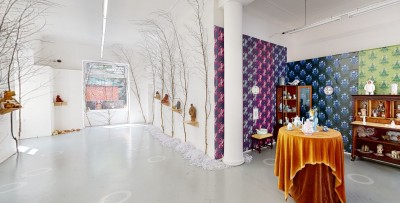KIMBA FRANCES KERNER DELIRIUM DECADENCE
14.04 – 26.06.2023 KIMBA FRANCES KERNER DELIRIUM DECADENCE
Curator: Magda Kardasz
Exhibition production: Pola Gadowska, Kacper Pielaszek, Grzegorz Ostromecki and team
I heard a great deal, many lies and falsehoods, but the longer I lived the more I understood that there were really no lies. Whatever doesn’t really happen is dreamed at night. It happens to one if it doesn’t happen to another, tomorrow if not today, or a century hence if not next year. Often I heard tales of which I said, ‘Now this is a thing that cannot happen.’ But before a year had elapsed I heard that it actually had come to pass somewhere.
Going from place to place, eating at strange tables, it often happens that I spin yarns — improbable things that could have never happened — about devils, magicians, windmills, and the like. The children run after me, calling: ‘Grandpa, tell us a story.’
Isaac Bashevis Singer, Gimpel the Fool and Other Stories, Goodreads Press, 2021, p. 20
Kimba Frances Kerner was born in the United States, but she lives and works in Warsaw. In 2017, she began her Ph.D. studies at the Academy of Fine Arts in Warsaw, where she discovered artistic printmaking, which she has been exploring ever since. She specialises in the innovative combination of ceramics and graphics (she is developing a research and artistic project dedicated to graphic transfers on ceramics).
This is how she describes her work: ‘I combine the themes of psychology, narrative and animism using a variety of media. I’m interested in exploring my own psyche, subconsciousness, and memory. I often draw on my childhood memories, fairy tales and myths, which I deconstruct to build my own stories.’
Fascinated by the world created by Isaac Bashevis Singer, which is rooted in Jewish tradition, the artist incorporates motifs from this world into her work, as well as elements from various ancient mythologies and folk legends, or symbols from the disciplines of magic and alchemy. To get an idea of the breadth of this pantheon, the gallery of psychological types and the world of imagination, it is enough to mention the titles of selected sculptures in the exhibition: Earth Spirit, Desert Guardian, The Muse of Eloquence, Kitsune, Succubus, Golem, Dybbuk, The Watcher, Imp, Ghost Girl, Outsider, The Golden Calf, Melancholy, Lilith, Zlateh, The Devil or the titles of the artist’s solo exhibitions: Golems, Dybbuks and Witches, Alchemy and Transformation, Lantuchs. The author emphasises that the repetition of motifs across different myths illustrates the continuity of human nature.
Joseph Campbell, an American scholar of comparative mythology and religion (inspired by Jungian thought) and the artist’s favourite writer, sought to identify common themes in myths from around the world that speak to the universal needs of the human spirit. He believed that ‘myths are clues to the spiritual potentialities of the human life’. He wrote: ‘I think that what we’re seeking is an experience of being alive, so that our life experiences on the purely physical plane will have resonances within our own innermost being and reality, so that we actually feel the rapture of being alive. That’s what it’s all finally about, and that’s what these clues help us to find within ourselves.’ (Joseph Campbell, The Power of Myth, Anchor, 2011, pp. 4–5)
Drawing from a variety of sources, Kimba Frances Kerner creates new stories from her own unique perspective and in dialogue with those sources. (Another notable artist who comes to mind here is Luigi Serafini, who, in his Codex Seraphinianus from the 1970s, wrote in an imaginary language and drew a fantastic world that served as a kind of parody of the real world).
The exhibition at the Zachęta Project Room has been an opportunity for Kimba Frances Kerner to prepare an all-out installation entitled Delirium Decadence. It features small-size ceramic sculptures, the artist’s personal bestiary, as well as collage graphics on ceramic vessels and duplicated on a plastic base (imitating old wallpaper). The artist juxtaposes two worlds: on the ground floor of the gallery there is a decadent salon that seems to represent the declining, degenerate phase of some cultural formation (Rococo rather than Baroque). The epoch in which the bond between human beings and their own selves and the surrounding nature was broken, leaving it vulnerable to destruction. The sculptures are placed in a sophisticated set composed of furniture — ‘antiques’, architectural elements and organic elements found by the artist in the forest.
Kerner transformed the underground part of the gallery into a dark cave that smells of earth after the rain. Sculpted by the artist, the little heroes seem to emerge from the ground like sprouts in spring. The green light emanating from behind the stalactites and stalagmites can offer hope for the rebirth of people, nature and the planet. At least that is what I would like to see at any cost.
Kimba Frances Kerner defines her exhibition as a metaphorical representation of the known (physical) and unknown (spiritual) worlds that can meet at special moments. In this way, in her work she pays tribute to the undiscovered secrets.
Magda Kardasz
KIMBA FRANCES KERNER
DELIRIUM DECADENCE
14.04 – 26.06.2023
Zachęta Project Room
ul. Gałczyńskiego 3, 00-362 Warsaw
See on the map
Godziny otwarcia:
tuesday–Sunday 12–8 p.m.
free entry

